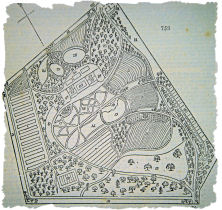
Botanical and Scientific Society Arboretums
![]() y the early nineteenth century, botanical society gardens usually incorporated arboretums within such as those at Glasgow, Dublin, Edinburgh, Cork, Hull, Liverpool, Manchester and Birmingham. The design of these arboretums was strongly influenced by the demands of botanical education and experimentation, however the need to attract visitors and subscribers encouraged the designers to apply aesthetic and landscape gardening principles.
y the early nineteenth century, botanical society gardens usually incorporated arboretums within such as those at Glasgow, Dublin, Edinburgh, Cork, Hull, Liverpool, Manchester and Birmingham. The design of these arboretums was strongly influenced by the demands of botanical education and experimentation, however the need to attract visitors and subscribers encouraged the designers to apply aesthetic and landscape gardening principles.
The garden of the Botanical Society at Glassnevin, Dublin for instance, included a ‘Hortus Linnaeensis’, a ‘Hortus Jussieuensis’ comprising all the orders of hardy specimens in Britain and ‘Hortus Hibernicus’ of native Irish plants.
Plan of Glasgow Botanic Garden from Loudon's Encyclopedia of Gardening (1830). ( Click here to enlarge)

The botanic garden at Trinity College in the city begun in 1807 featured separate arrangements for trees, shrubs and herbaceous plants arranged according to the Linnaean system and medicinal plants arranged by the natural system.
Most influential in England, however, were the arboretums of the Horticultural Society in the gardens at Turnham Green, London and the arboretum of the Royal Botanic Gardens at Kew.
The former was regarded as ‘the first in England’ and visited by thousands of members, subscribers and their guests each year and also serving as the most important centre for training gardeners and labourers.
The latter usurped this position during the 1850s after a major new arboretum was introduced designed by William Nesfield with the encouragement of William Hooker. This was intended to be the pre-eminent tree collection in the nation and empire and greatly extended the collection of trees and shrubs that had been established in the royal gardens during the previous century.